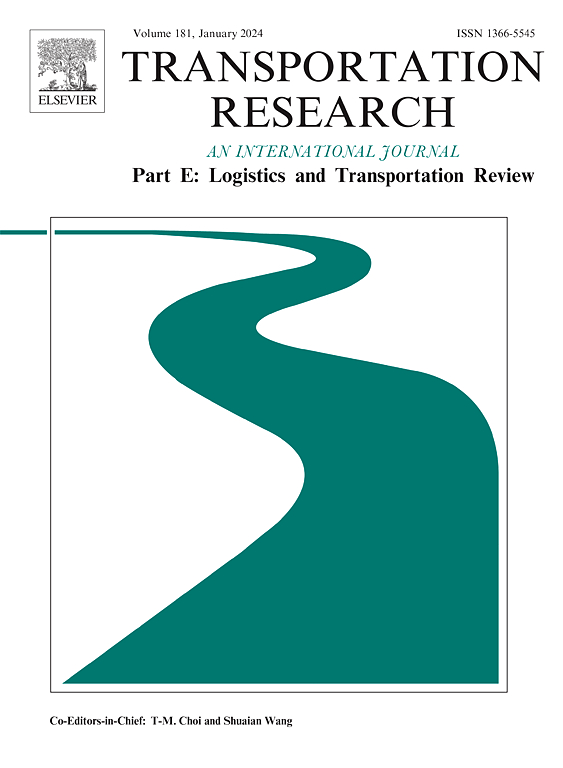Development, Calibration, and validation of a Novel nonlinear Car-Following Model: Multivariate piecewise linear approach for adaptive cruise control vehicles
IF 8.3
1区 工程技术
Q1 ECONOMICS
Transportation Research Part E-Logistics and Transportation Review
Pub Date : 2025-05-06
DOI:10.1016/j.tre.2025.104031
引用次数: 0
Abstract
As advanced driver-assistance systems (ADAS) are more widely implemented—particularly the adaptive cruise control (ACC) system in car-following behavior—accurate modeling of ACC vehicles’ behavior is needed. Currently, each vehicle manufacturer develops its ACC systems with unique controllers, creating “black boxes” that are not openly accessible for analysis. In addition, the vehicle dynamics that use sensor and dynamics systems introduce complicated inherent nonlinearity in ACC-equipped vehicles’ behaviors (hereinafter referred to as ACC vehicles). Given the complex inherent nonlinearity of ACC systems, traditional vehicle behavior modeling methods have to trade off between modeling accuracy and interpretability. To address these challenges, this study introduces an innovative multivariate piecewise linear (MPL) car-following modeling methodology to emulate any ACC system from observational data. The MPL modeling methodology allows for several empirical quantifications of the unknown design parameters of the different ACC systems as they are manifested in the vehicles’ driving behavior. This approach distinguishes itself from traditional piecewise linear models by incorporating multiple breakpoints. These breakpoints serve to capture the inherent nonlinearity of ACC vehicle dynamics across a range of linear functions. Simultaneously, these breakpoints are empirically derived from actual trajectory data, thereby enhancing modeling accuracy. A case study illustrates four calibrated MPL models based on a large-scale field automated vehicle experiment dataset. Compared to other models, the MPL models show sufficient accuracy and interpretability. This robust and transparent modeling methodology may serve as an analytical tool for future transportation planning.
一种新型非线性车辆跟随模型的开发、校准和验证:自适应巡航控制车辆的多元分段线性方法
随着先进驾驶辅助系统(ADAS)的广泛应用,特别是自适应巡航控制(ACC)系统在汽车跟随行为中的应用,需要对ACC车辆的行为进行精确建模。目前,每个汽车制造商开发的ACC系统都有独特的控制器,形成了无法公开分析的“黑匣子”。此外,使用传感器和动力学系统的车辆动力学在配备ACC的车辆(以下简称ACC车辆)的行为中引入了复杂的固有非线性。由于自动控制系统固有的复杂非线性,传统的车辆行为建模方法必须在建模精度和可解释性之间进行权衡。为了应对这些挑战,本研究引入了一种创新的多变量分段线性(MPL)汽车跟随建模方法,用于从观测数据模拟任何ACC系统。MPL建模方法允许对不同ACC系统的未知设计参数进行几个经验量化,因为它们体现在车辆的驾驶行为中。这种方法与传统的分段线性模型不同,它结合了多个断点。这些断点用于捕获ACC车辆动力学在一系列线性函数中的固有非线性。同时,这些断点是根据实际轨迹数据经验推导出来的,从而提高了建模的精度。以大型现场自动驾驶汽车实验数据集为例,给出了四种校正后的MPL模型。与其他模型相比,MPL模型具有足够的精度和可解释性。这种稳健、透明的建模方法可作为未来交通规划的分析工具。
本文章由计算机程序翻译,如有差异,请以英文原文为准。
求助全文
约1分钟内获得全文
求助全文
来源期刊
CiteScore
16.20
自引率
16.00%
发文量
285
审稿时长
62 days
期刊介绍:
Transportation Research Part E: Logistics and Transportation Review is a reputable journal that publishes high-quality articles covering a wide range of topics in the field of logistics and transportation research. The journal welcomes submissions on various subjects, including transport economics, transport infrastructure and investment appraisal, evaluation of public policies related to transportation, empirical and analytical studies of logistics management practices and performance, logistics and operations models, and logistics and supply chain management.
Part E aims to provide informative and well-researched articles that contribute to the understanding and advancement of the field. The content of the journal is complementary to other prestigious journals in transportation research, such as Transportation Research Part A: Policy and Practice, Part B: Methodological, Part C: Emerging Technologies, Part D: Transport and Environment, and Part F: Traffic Psychology and Behaviour. Together, these journals form a comprehensive and cohesive reference for current research in transportation science.

 求助内容:
求助内容: 应助结果提醒方式:
应助结果提醒方式:


